















Buick Century |
|---|
|
| Topic Navigation |
|---|
|
Wikipedia: Buick Century
Page Sections History Bibliography Images Documents |
History
The following section is an excerpt from Wikipedia's Buick Century page on 22 June 2018, text available via the Creative Commons Attribution-ShareAlike 3.0 Unported License.
Buick Century is the model name used by Buick for a line of upscale performance cars from 1936 to 1942 and 1954 to 1958, and from 1973 to 2005 for a mid-size car.
The model name Century came about when Buick was designing its first production automobile capable of reaching a speed of 100 mph. The division needed to come up with a name. One of the Buick executives had returned from a recent trip to Britain, and told the other executives that the British referred to going 100 mph as "doing the century". The executives liked the Century name and it stuck.
The Century was sold as the Buick Regal in Japan, as Toyota owns the right to the name Century.
Series 60 (1930-1935)
Originally the Series 60 had a six-cylinder 331.4 cu in (5,431 cc) engine, developing 99 bhp at 2,800 rpm. It had, at the beginning of the generation, a full length running board denoting the top model for Buick at the time. In 1930, GM built 38,180 cars. The bodystyles available were torpedo, sedan, coupe, and roadster convertible, using GM's "B-body" platform.
In 1931 the running board was reduced and a new straight eight-cylinder 272.6 cu in (4,467 cc) engine and 90 bhp. Aesthetically, the Series 60 remained almost unchanged and the same fact occurred also in the following year. In 1931 and 1932 they were produced 55,135 examples.
In 1933 the length of the body increased. The engine power increased to 97 hp. In 1934 the appearance was discontinued to a more rounded appearance, with a new 278.1 cu in (4,557 cc) eight-cylinder engine and 100 hp. In 1935 the model remained almost unchanged. From 1933 to 1935 the car were produced 31,385 copies. In 1936 the model changed its name to "Century".
First generation (1936–1942)
Buick renamed its entire model lineup for the 1936 model year to celebrate the engineering improvements and design advancements over their 1935 models, introducing a "streamlined" appearance. Buick's Series 40 model range became the Special, the Series 80 became the Roadmaster and the Series 90—Buick's largest and most luxurious vehicles, became the Limited. The Century took the place of the Series 60.
The basic formula for the 1936 to 1942 Century was established by mating the shorter behind the engine cowl Special bodies to the Roadmaster's larger straight-eight engine (and consequently longer engine compartment). (In contrast the 1940 Series 50 Super would combine the larger Roadmaster body with the smaller Special engine.) While the Special was powered by Buick's 233 cu in inline-8 was rated 93 hp (69 kW) at 3200 rpm, Centuries produced between 1936 and 1942 were powered by the 320-cubic-inch producing 165 hp, making them the fastest Buicks of the era and capable of sustained speeds of 100 mph, hence the name Century (100), earning the Century the nickname "the banker's hot rod."
The Century was discontinued at the end of the abbreviated 1942 model year, during which total model production only accounted for about ten percent of Buick's total output.
Second generation (1954–1958)
In 1954, Buick reintroduced the Century using the same formula of mating the smaller, lighter Buick Special body to its largest and most powerful 322 cubic inch V8 engine with the intent of giving Buick a performance vehicle. Included in the model lineup during this period was a station wagon model, a body style that had been unavailable during the Century's first production period of 1936 to 1942.
Introduced in the middle of the 1955 model year the 4-door Buick Century Riviera along with the 4-door Special Riviera and the 4-door Oldsmobile 98 Holiday and 4-door 88 Holiday, were the first 4-door hardtops ever produced. This was the first time "VentiPorts" appeared on the Century, a carryover from the Buick Roadmaster.
In 1955, the California Highway Patrol placed a large fleet order for Century 2-door sedans, a body style unavailable to the general public. It combined the Special 2-door sedan body shell with Century powertrain and trim. Broderick Crawford was shown driving a 2-door Century sedan during the first season of his popular syndicated TV series Highway Patrol. (In later seasons he'd drive a four-door Century, like his real life counterparts in the California Highway Patrol.) Power brakes were optional. Tubeless tires were new.
The Century remained Buick's performance line, with engine power rising from 200 (SAE gross) in 1954, to 236 in 1955, to 255 in 1956, and topping out at 300 from a bored-out 364 cu in (6.0 L) engine in 1957–58, the last model years for the full sized Century line.
For 1959, Buick renamed the Century the Invicta.
Third generation (1973–1977)
The Buick Century nameplate was revived for the 1973 model year on the rear-wheel drive intermediate A-body platform, which was redesigned for this year. The name replaced Skylark for Buick's mid-size cars. The Century Regal coupe was added at the top of the model range and would later become a separate series, dropping the Century name. It was available with two- and four-barrel versions of the Buick 350, putting out 150 and 175 horsepower (112 and 130 kW) respectively. The 225 hp (168 kW) 455 was also an option. The base Century and Century 350 coupes had a fastback roof with large rear quarter glass, while the Century Luxus featured a more formal notchback roofline with narrow opera windows.
By replacing the Skylark, the Century inherited the Gran Sport performance option. The package was available with any engine and included upgraded suspension, additional instrumentation, and unique appearance treatment. Dual exhaust increased output of the four-barrel 350 to 190 hp (140 kW). While the Stage I 455 was somewhat diminished from its performance heyday due to emission controls, output was competitive for the era at 270 hp (200 kW) and 390 lb⋅ft (530 N⋅m). A Saginaw three-speed manual was standard with either 350 engine. A Muncie M-21 four-speed was available with either 350 or with the regular 455, while the Stage I required a Turbo-Hydramatic 400.
Fourth generation (1978–1981)
In 1978, GM downsized its intermediate line, reducing wheelbase by four inches and curb weight by nearly half a ton. The Century name was now applied to the entire range except for the coupe, which retained the Regal name. A fastback coupe ("aeroback") and aeroback sedan were added (the body was shared with the Oldsmobile Cutlass Salon), which was a revival of an appearance used in the late 1940s on the Buick Super and again in the late 1960s on the Buick Skylark. It was also offered as a station wagon and two- and four-door notchbacks. The car was over a foot shorter, several inches narrower, and several hundred pounds lighter than its predecessor. V6 engines were still standard due to fuel economy regulations. Big block engines were gone and the new base powerplant was Buick's new 196 cu in (3.2 L) V6, introduced specifically for the Century and Regal. The 231 cu in (3.8 L) V6, and the Chevrolet 305 V8 were options. The Pontiac 265 cu in (4.3 L) and 301 cu in (4.9 L) replaced the Chevrolet engine for 1979.
One of the more rare models of this time was the 1979 to 1980 Century Turbo Coupe, powered by a turbocharged version of the 3.8 L V6, which offered V8-like performance with more reasonable fuel consumption and reduced emissions. The Turbo Coupe was not nearly as popular as the similar Regal Turbo Sport Coupe of the time, and total production is estimated to be less than 2,500.
Fifth generation (1982–1996)
In 1982, another downsized Century arrived, this time on the front wheel drive A platform, in coupe and sedan form. In 1984, a station wagon was added to the lineup to replace the departed Regal wagon. 1984 also saw an Olympic version of the Buick Century, commemorating the 1984 games in Los Angeles, California. In 1986, all versions were "freshened" with a new, more angular front fascia. Wheelbase was 104.9 in (2664 mm), with 189 in (4800mm) overall length. Both four-cylinder gasoline units and diesel V6 engines were offered in this generation, although neither became popular. Performance versions of several Buick models, including the Century coupe, were offered in the mid-1980s under the T-Type name. With Buick's 181 cu in (3.0 L) V6 producing 110 hp (82 kW), the Century T-Type's performance was modest, but the 3.8 SFI engine, producing 140-150 hp (105-112 kW), offered spirited performance in this comparatively lightweight vehicle.
In 1985 and 1986, Hess & Eisenhardt/Car Craft of Lima, Ohio converted 124 finished Buick Century coupes into coachbuilt convertibles. Although these convertibles were sold as new cars through Buick dealerships, these convertible conversions were not factory authorized. In 1987, the engine distributor was replaced by a coil-pack ignition system that proved to be far more reliable than the system that it replaced. In the Japanese market Buick could not use the "Century" name, as that was already in use for the Toyota Century, so it was marketed as the "Buick Luxus" instead. Later it was sold in Japan as the Buick Regal at Yanase Co., Ltd. dealerships for a short time. The Venezuelan-built models were sold as the "Chevrolet Century" in South America and the Caribbean. In Mexico, it was sold as the Century Limited (with no brand, although it wears the Buick logos). Introduced in 1984, it was the top model for General Motors Mexico, it survived successfully the import car wave from 1991 (previously new car importations were forbidden in Mexico) and continued in production until the 1996 model year.
Sixth generation (1997–2005)
The Century was redesigned for the last time in 1997. The four-door sedan was the only body style offered (the station wagon was dropped due to decreasing sales), and was still a front wheel drive V6-powered configuration. Plainer "Custom" and fancier "Limited" trim levels were carried over from the previous generation. The 1997 redesign moved Centurys to the W-body platform, rejoining its former Regal sibling. In this generation, the Century and Regal were nearly the same car, distinguished only by seating configurations, trim, and engine differences. Since the Century was lower-priced than the Regal, it was also the lower-powered and plainer of the two, offering only a 3.1 L V6. In keeping with its traditional image, the 6-passenger Century came equipped with a front bench seat and column shifter, while the more performance-oriented 5-passenger Regal came standard with front bucket seats and console shifter. After the 1998 discontinuation of the Skylark, the Century for the first time became Buick's entry-level car. Buick tried to position the Century as a lower-priced alternative to Japanese family sedans like the Toyota Camry and Honda Accord. However, it failed to compete with them and was instead widely viewed as a car designed for an elderly target audience, an image not helped by the Century's assortment of senior citizen-friendly features like extra-large dashboard buttons and an extremely soft suspension. For 2003, all trim levels were eliminated, leaving one standard model. Additionally, the "Century" nameplate on the front doors was dropped, and only seen on the vehicle's taillights.
Changes were relatively few over the Century's nine-year run. The all-new Buick LaCrosse replaced both the Century and Regal in 2005. A limited run of Centurys with special trim were produced for 2005 to mark the end of the name. GM rolled the last Buick Century off the Oshawa assembly line on October 25, 2004.
| Title & Subtitle | Details |
|---|---|
Buick Regal and Century Automotive Repair Manual1974 thru 1987 | Year & Type: 1987 Service Manual Authors: Peter D. du Pré & John H. Haynes Publisher: Haynes Publishing Group Dimensions: 8.25" x 10.625" softcover Content: 339 pages w/black & white photos ISBN: 1-85010-386-0 Topics: Buick Century, Buick Regal Availability: Reference Desk |
General Motors A-Cars Automotive Repair Manual1982 thru 1996 | Year & Type: 1998 Service Manual Authors: Gradon Mechtel, Larry Warren, and John H. Haynes Publisher: Haynes Publishing Group Dimensions: 8.5" x 10.5" softcover Content: 250+ pages w/black & white photos ISBN: 1-56392-209-6 Topics: Buick Century, Chevrolet Celebrity, Oldsmobile Cutlass Ciera, Oldsmobile Cutlass Cruiser, and Pontiac 6000 Availability: Reference Desk |
1988 Buick Service Manual Century | Year & Type: 1988 Service Manual Publisher: General Motors Corporation Dimensions: 8.5" x 11" softcover Content: 1,000+ pages w/black & white illustrations Topic: Buick Century Availability: Reference Desk |
1996 Buick Century and Oldsmobile Cutlass Ciera Service Manual Book 2 of 2 | Year & Type: 1996 Service Manual Publisher: General Motors Corporation Dimensions: 8.5" x 11" softcover Content: 600+ pages w/black & white illustrations Topics: Buick Century, Oldsmobile Cutlass Ciera Availability: Reference Desk |
1997 Pontiac Grand Prix, Buick Century and Regal Service Manual Book 1 of 3 | Year & Type: 1997 Service Manual Publisher: General Motors Corporation Dimensions: 8.5" x 11" softcover Content: 1,200+ pages w/black & white illustrations Topics: Pontiac Grand Prix, Buick Century, and Buick Regal Availability: Reference Desk |
GM A-Body 1982-85All U.S. and Canadian models of front-wheel drive BUICK Century · CHEVROLET Celebrity · OLDSMOBILE Ciera · Pontiac 6000 | Year & Type: 1985 Service Manual Publisher: Chilton Book Company Dimensions: 6.5" x 10" softcover Content: 218 pages w/black & white illustrations ISBN: 0-8019-7586-7 Topics: Buick Century, Chevrolet Celebrity, Oldsmobile Cutlass Ciera, and Pontiac 6000 Availability: Reference Desk |
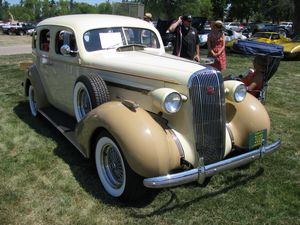 |
Subject: 1936 Buick Century
Photographer: Bill Crittenden Event: 2012 The Cars Time Forgot 
View photo of 1936 Buick Century - 4.2MB |
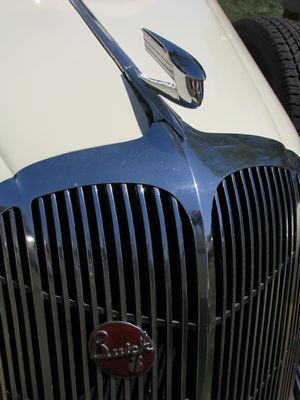 |
Subject: 1936 Buick Century
Photographer: Bill Crittenden Event: 2012 The Cars Time Forgot 
View photo of 1936 Buick Century - 2.8MB |
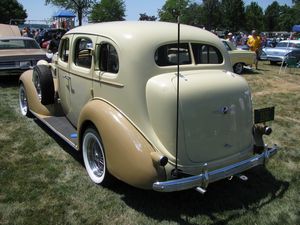 |
Subject: 1936 Buick Century
Photographer: Bill Crittenden Event: 2012 The Cars Time Forgot 
View photo of 1936 Buick Century - 3.8MB |
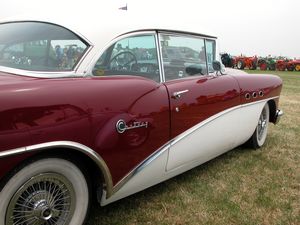 |
Subject: Buick Century
Source: Image*After View photo of Buick Century - 935KB |
| Subject: 1955 Buick Century Riviera
Photographer: Bill Crittenden Event: 2013 Mecum Chicago Auction 
Auction Info: Reserve not met, high bid $13,000. View photo of 1955 Buick Century Riviera - 3.2MB | |
| Subject: 1955 Buick Century Riviera
Photographer: Bill Crittenden Event: 2013 Mecum Chicago Auction 
Auction Info: Reserve not met, high bid $13,000. View photo of 1955 Buick Century Riviera - 3.2MB | |
| Subject: 1955 Buick Century Riviera
Photographer: Bill Crittenden Event: 2013 Mecum Chicago Auction 
Auction Info: Reserve not met, high bid $13,000. View photo of 1955 Buick Century Riviera - 3.2MB | |
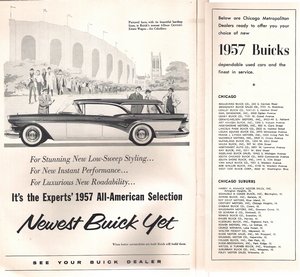 |
Subject: 1957 Buick Century Caballero Advertisement
Source: Chicago Bears vs. Chicago Cardinals game program Date: 9 December 1956 View 1957 Buick Century Caballero Advertisement - 4,128KB |
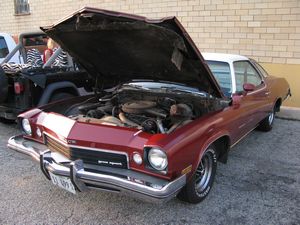 |
Subject: 1973 Buick Century GS
Photographer: Bill Crittenden Event: Green Street Cruise Night: 21 July 2014 
View photo of 1973 Buick Century GS - 2.4MB |
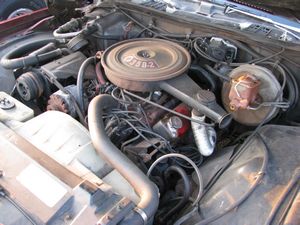 |
Subject: 1973 Buick Century GS
Photographer: Bill Crittenden Event: Green Street Cruise Night: 21 July 2014 
View photo of 1973 Buick Century GS - 2.2MB |
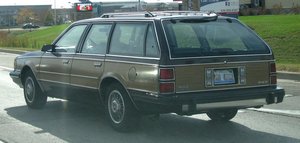 |
Subject: Buick Century Station Wagon
Photographer: Bill Crittenden Date: 2010 View photo of Buick Century Station Wagon - 1,807KB |
